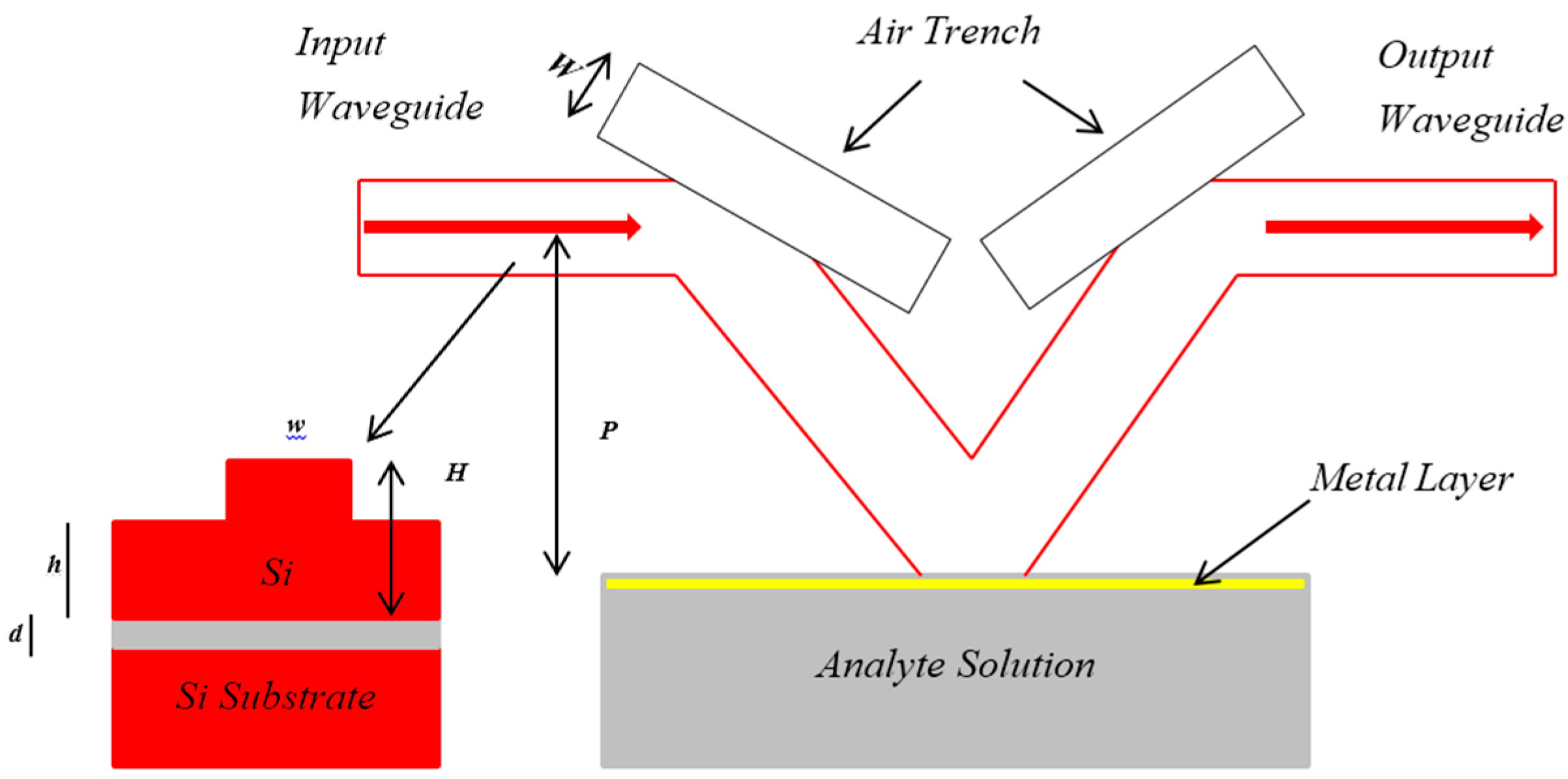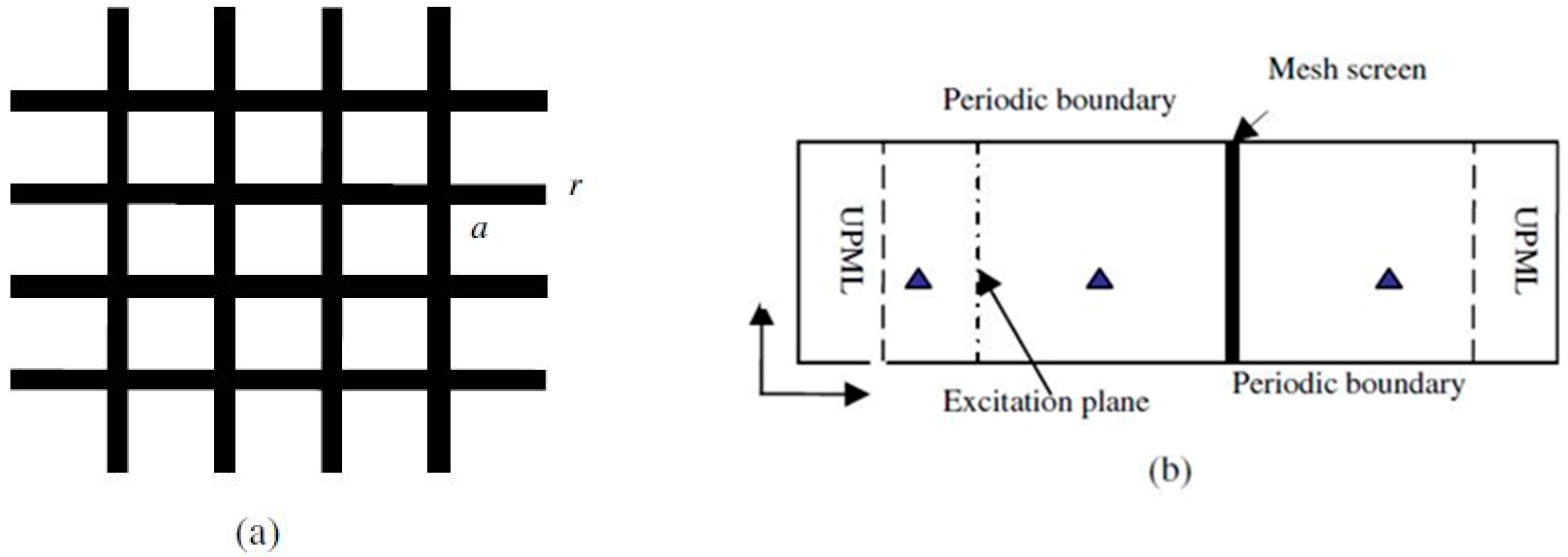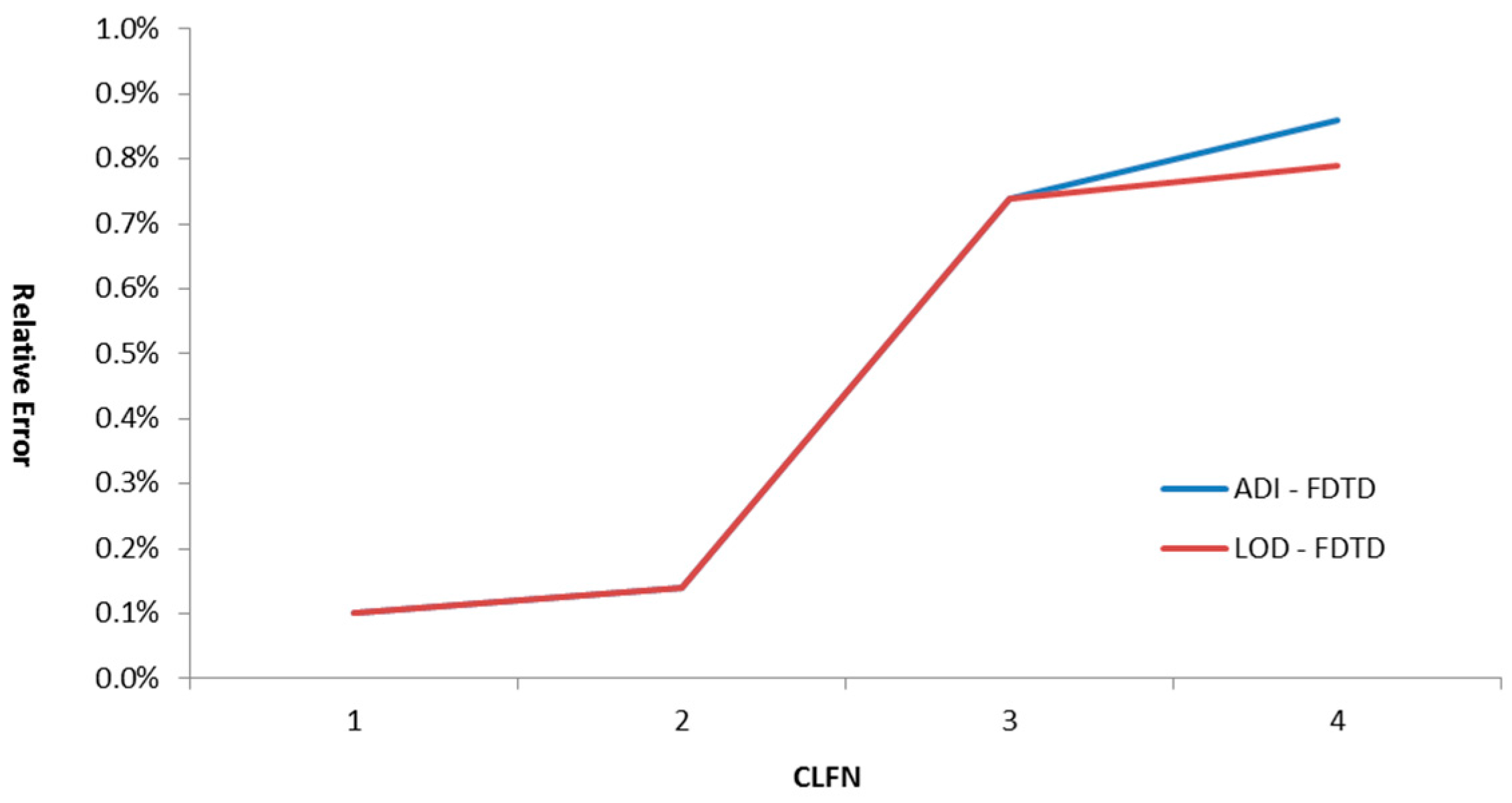Comprehensive Numerical Analysis of Finite Difference Time Domain Methods for Improving Optical Waveguide Sensor Accuracy
Abstract
:1. Introduction
1.1. Optical Planar Waveguide
1.2. Optical Rib Waveguide Array
2. Basic FDTD Methods
2.1. Recursive Convolution (RC) Method
2.2. Direction Implicit (DI) Method
3. Improved FDTD Methods
3.1. Alternating Direction Implicit (ADI) Method
3.2. Locally One-Dimensional (LOD) Technique
4. Improving the Optical Waveguide Sensor’s Accuracy
5. Conclusions
Acknowledgments
Author Contributions
Conflicts of Interest
References
- Young, J.L. A full finite difference time domain implementation for radio wave propagation in a plasma. Radio Sci. 1994, 29, 1513–1522. [Google Scholar] [CrossRef]
- Nickisch, L.J.; Franke, P.M. Finite-difference time-domain solution of Maxwell’s equations for the dispersive ionosphere. IEEE Antennas Propag. Mag. 1992, 34, 33–39. [Google Scholar] [CrossRef]
- Luebbers, R.J.; Hunsberger, F.; Kunz, K.S. A frequency-dependent finite-difference-time-domain formulation for transient propagation in a plasma. IEEE Trans. Antennas Propag. 1991, 39, 29–34. [Google Scholar] [CrossRef]
- Kelley, D.F.; Luebbers, R.J. Piecewise linear recursive convolution for dispersive media using FDTD. IEEE Trans. Antennas Propag. 1996, 44, 792–797. [Google Scholar] [CrossRef]
- Hunsberger, F.; Luebbers, R.; Kunz, K. Finite-difference time domain analysis of gyrotropic media—I: Magnetized plasma. IEEE Trans. Antennas Propag. 1992, 40, 1489–1495. [Google Scholar] [CrossRef]
- Siushansian, R.; LoVetri, J. A comparison of numerical techniques for modeling electromagnetic dispersive media. IEEE Microw. Guided Wave Lett. 1995, 5, 426–428. [Google Scholar] [CrossRef]
- Luebbers, R.J.; Hunsberger, F.; Kunz, K.S.; Standler, R.; Schneider, M. A frequency-dependent finite-difference-time-domain formulation for dispersive materials. IEEE Trans. Electromagn. Compat. 1990, 32, 222–227. [Google Scholar] [CrossRef]
- Kashiwa, T.; Yoshida, N.; Fukai, I. Transient analysis of a magnetized plasma in three-dimensional space. IEEE Trans. Antennas Propag. 1988, 36, 1096–1105. [Google Scholar] [CrossRef]
- Sullivan, D.M. Z-transform theory and the FDTD method. IEEE Trans. Antennas Propag. 1996, 44, 28–34. [Google Scholar] [CrossRef]
- Homola, J.; Yee, S.S.; Gauglitz, G. Surface plasmon resonance sensors: Review. Sens. Actuators B Chem. 1999, 54, 3–15. [Google Scholar] [CrossRef]
- Bouchard, S.; Thibault, S. GRIN planar waveguide concentrator used with a single axis tracker. Opt. Express 2014, 22, 248–258. [Google Scholar] [CrossRef] [PubMed]
- Hanemann, T.; Böhm, J.; Honnef, K.; Ritzhaupt-Kleissl, E.; Haußelt, J. Polymer/phenanthrene-derivative host-guest systems: Rheological, optical and thermal properties. Macromol. Mater. Eng. 2007, 292, 285–294. [Google Scholar] [CrossRef]
- Šípová, H.; Homola, J. Surface plasmon resonance sensing of nucleic acids: A review. Anal. Chim. Acta 2013, 773, 9–23. [Google Scholar] [CrossRef] [PubMed]
- Dong, Y.; Liu, Y.; Li, T. Design of a High-Performance Micro Integrated Surface Plasmon Resonance Sensor Based on Silicon-On-Insulator Rib Waveguide Array Dengpeng Yuan. Sensors 2015, 15, 17313–17328. [Google Scholar]
- Zheng, F. Novel Unconditionally Stable FDTD Method for Electromagnetic and Microwave Modeling. Ph.D. Thesis, Dalhousie University, Halifax, NS, Canada, 2001. [Google Scholar]
- Joseph, R.M.; Hagness, S.C.; Taflove, A. Direct time integration of Maxwell’s equations in linear dispersive media with absorption for scattering and propagation of femtosecond electromagnetic pulses. Opt. Lett. 1991, 16, 1412–1414. [Google Scholar] [CrossRef] [PubMed]
- Yee, K. Numerical solution of initial boundary value problems involving Maxwell’s equations in isotropic media. IEEE Trans. Antennas Propag. 1966, 14, 302–307. [Google Scholar]
- Namiki, T. 3-D ADI–FDTD Method—Unconditionally stable time domain algorithm for solving full vector Maxwell’s equations. IEEE Trans. Microw. Theory Tech. 2000, 48, 1743–1748. [Google Scholar] [CrossRef]
- Lee, J.; Fornberg, B. A split-step approach for the 3-D Maxwell’s equations. J. Comput. Appl. Math. 2003, 158, 485–505. [Google Scholar] [CrossRef]
- Fu, W.; Tan, E.L. Development of split-step FDTD method with higher-order spatial accuracy. Electron. Lett. 2004, 40, 1252–1254. [Google Scholar] [CrossRef]
- Shibayama, J.; Muraki, M.; Yamauchi, J.; Nakano, H. Efficient implicit FDTD algorithm based on locally one-dimensional scheme. Electron. Lett. 2005, 41, 1046–1047. [Google Scholar] [CrossRef]
- Do Nascimento, V.E.; Borges, B.-H.V.; Teixeira, F.L. Split-field PML implementations for the unconditionally stable LOD–FDTD method. IEEE Microw. Wirel. Compon. Lett. 2006, 16, 398–400. [Google Scholar] [CrossRef]
- Sarma, M.S. Potential Functions in Electromagnetic Field problems. IEEE Trans. Mag. 1970, 6, 513–518. [Google Scholar] [CrossRef]
- Mitchell, A.R.; Griffiths, O.F. The Finite Difference Method in Partial Difference Equations; Wiley: New York, NY, USA, 1980. [Google Scholar]
- Schweig, E.; Brdidges, W.B. Computer Analysis of Dielectric Waveguides, A Finite Difference Method. IEEE Trans. Microw. Theory Tech. 1984, 32, 531–541. [Google Scholar] [CrossRef]
- Islmiov, I.J. The definition of netimate power transmitting along rectilinear waveguide with air filling. Uchenie Zapiski AzTU 2001, X, 69–70. [Google Scholar]
- Ahmed, I.; Chua, E.K.; Li, E.P.; Chen, Z. Development of the three-dimensional locally one-dimensional (LOD) FDTD method and proved unconditional numerical stability. IEEE Trans. Antennas Propag. 2008, 56, 3596–3600. [Google Scholar] [CrossRef]
- Kung, F.; Chuah, H.T. A Finite Difference Time Domain Software for Simulation of Printed Circuit Board (PCB) Assembly. Prog. Electromagn. Res. 2005, 50, 299–335. [Google Scholar] [CrossRef]






| Mathematical Results (GHz) | ADI–FDTD | Kane Yee Scheme | ||
|---|---|---|---|---|
| Simulation Results (GHz) | Relative Error | Simulation Results (GHz) | Relative Error | |
| 19.4270 | 19.4000 | 0.14% | 19.4510 | 0.12% |
| 26.0220 | 25.6910 | 0.23% | 25.9720 | 0.19% |
| 31.6520 | 31.5330 | 0.31% | 31.4550 | 0.62% |
| 34.7760 | 34.5770 | 0.57% | 34.6130 | 0.47% |
| Mathematical Results (GHz) | ADI–FDTD | Kane Yee Scheme | ||
|---|---|---|---|---|
| Simulation Results (GHz) | Relative Error | Simulation Results (GHz) | Relative Error | |
| 18.6270 | 18.5870 | 0.21% | 18.6100 | 0.11% |
| 27.1720 | 27.0460 | 0.46% | 27.1200 | 0.19% |
| 29.3740 | 29.1550 | 0.88% | 29.2250 | 0.51% |
| 32.8810 | 32.6260 | 0.77% | 32.6710 | 0.64% |
| 35.0690 | 34.8320 | 0.67% | 34.9460 | 0.35% |
| Arithmetic Operations | ADI-FDTD | LOD-FDTD | |
|---|---|---|---|
| Implicit | M/D | 18 | 12 |
| A/S | 48 | 30 | |
| Explicit | M/D | 12 | 6 |
| A/S | 24 | 24 | |
| Total | M/D | 30 | 18 |
| A/S | 72 | 54 | |
| Analytical GHz | ADI-FDTD | LOD-FDTD | ||
|---|---|---|---|---|
| GHz | Relative Error | GHz | Relative Error | |
| 19.43 | 19.45 | 0.10% | 19.45 | 0.10% |
| 25.00 | 25.01 | 0.04% | 25.01 | 0.04% |
| 31.66 | 31.47 | 0.60% | 31.47 | 0.60% |
| 42.85 | 42.80 | 0.12% | 42.87 | 0.05% |
| Δt | Steps | CPU Time | Memory | |
|---|---|---|---|---|
| Kane Yee Scheme | 0.96225 ps | 2400 | 607.90 s | 9.55 Mb |
| ADI-FDTD | 0.96225 ps | 2400 | 5488.3 s | 23.6 Mb |
| LOD-FDTD | 0.96225 ps | 2400 | 5232.1 s | 23.6 Mb |
| 9.62250 ps | 240 | 524.10 s | 23.6 Mb | |
| 14.4338 ps | 160 | 348.80 s | 23.6 Mb |
© 2016 by the authors; licensee MDPI, Basel, Switzerland. This article is an open access article distributed under the terms and conditions of the Creative Commons by Attribution (CC-BY) license (http://creativecommons.org/licenses/by/4.0/).
Share and Cite
Samak, M.M.E.A.; Bakar, A.A.A.; Kashif, M.; Zan, M.S.D. Comprehensive Numerical Analysis of Finite Difference Time Domain Methods for Improving Optical Waveguide Sensor Accuracy. Sensors 2016, 16, 506. https://doi.org/10.3390/s16040506
Samak MMEA, Bakar AAA, Kashif M, Zan MSD. Comprehensive Numerical Analysis of Finite Difference Time Domain Methods for Improving Optical Waveguide Sensor Accuracy. Sensors. 2016; 16(4):506. https://doi.org/10.3390/s16040506
Chicago/Turabian StyleSamak, M. Mosleh E. Abu, A. Ashrif A. Bakar, Muhammad Kashif, and Mohd Saiful Dzulkifly Zan. 2016. "Comprehensive Numerical Analysis of Finite Difference Time Domain Methods for Improving Optical Waveguide Sensor Accuracy" Sensors 16, no. 4: 506. https://doi.org/10.3390/s16040506






